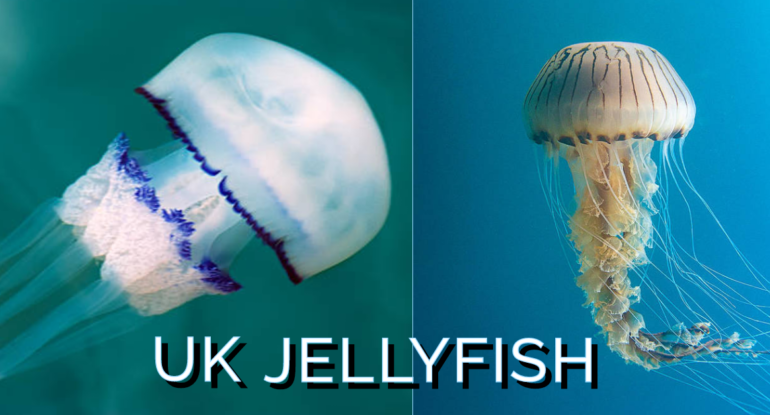UK Jellyfish Introduction:
There are hundreds of species of jellyfish in the world, however just a few UK Jellyfish are typically spotted both on the UK beach and under water.
The UK jellyfish can be find all through Britain and Ireland’s coastline, particularly in the summer time months. The umbrella is normally translucent, even as the inner organs frequently have an orange, purple or violet tinge to them.
Jellyfish Tentacles
The tentacles incorporate stinging cells that may inflict moderate pain (frequently compared to a nettle sting) if they arrive into touch with people. Like all UK jellyfish, the commonplace UK jellyfish are very negative swimmers that can simplest propel themselves weakly by means of contracting and lengthening their frame. Read our artivcle to discover what UK jellyfish you might have visible on neighborhood seashores close to you. Remember no longer to get too near, jellyfish UK can sting!
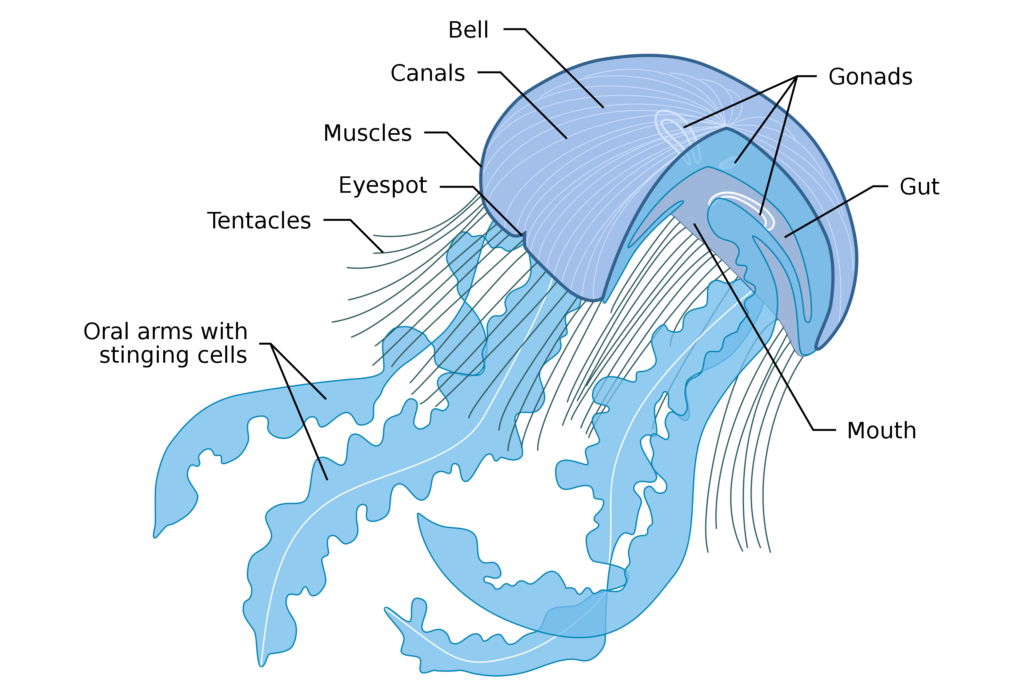
These species have tentacles which are ready with tiny stinging cells that are activated when these fish when they launch a sting attack on their prey. These tentacles are use to paralyze and stun the prey that the jellyfish stings. These tentacles are observe hanging from the jellyfish’s frame.
Types of UK Jellyfish
Below is the chart of UK Jellyfish which can be seen Under water.
| UK Jellyfish Name | Scientific Name | Jellyfish Bell | When & Where to see | |
| 1 | Barrel Jellyfish | Rhizostoma pulmo | Up to 90cm across | May to October Southern and Western coasts of Britain |
| 2 | Moon Jellyfish | Aurelia aurita | Up to 5-40cm | January to December |
| 3 | Blue Jellyfish | Cyanea lamarckii | up to 30cm across | May to October UK coastlines UK Seas and Coasts |
| 4 | Compass Jellyfish | Chrysaora hysoscella | Up to 30cm across | May to October Southern and Western coasts of Britain |
| 5 | Lion’s Mane Jellyfish | Cyanea capillata | Up to 50cm across | May to October Found off all UK coasts |
| 6 | Crystal Jellyfish | Aequorea Victoria | Up to 12 cm | Rrely seen in the UK, other than off the coast of Cornwall. |
| 7 | Cross Jelly | Mitrocoma cellularia | Up to 30 cm | further north than the UK |
| 8 | Mauve stinger jellyfish | Pelagia noctiluca | Up to 10cm | July to October It is rare in the UK and only found along the south coast in warm summers. |
| 9 | Portuguese Man O’War | Physalia physalis | Up to 30cm | Common across their range, rare on UK shores |
| 10 | By-the-wind-sailor | Velella velella | Up to 10cm | Sep to March around British and Irish coasts |
1- Barrel Jellyfish UK

Barrel is the largest UK jellyfish observed in UK river and seas. They are translucent with a massive mushroom formed bell and a bunch of 8 frilly tentacles underneath. They do not have marginal tentacles.
This kind has a very slight sting and may be determined in large numbers. They can grow pretty huge and commonly inhabit harbour waters. Barrel UK jellyfish grow as much as 1m in diameter. They have a spherical, stable rubbery bell, which can be white, light red or blue.
2- Moon UK Jellyfish
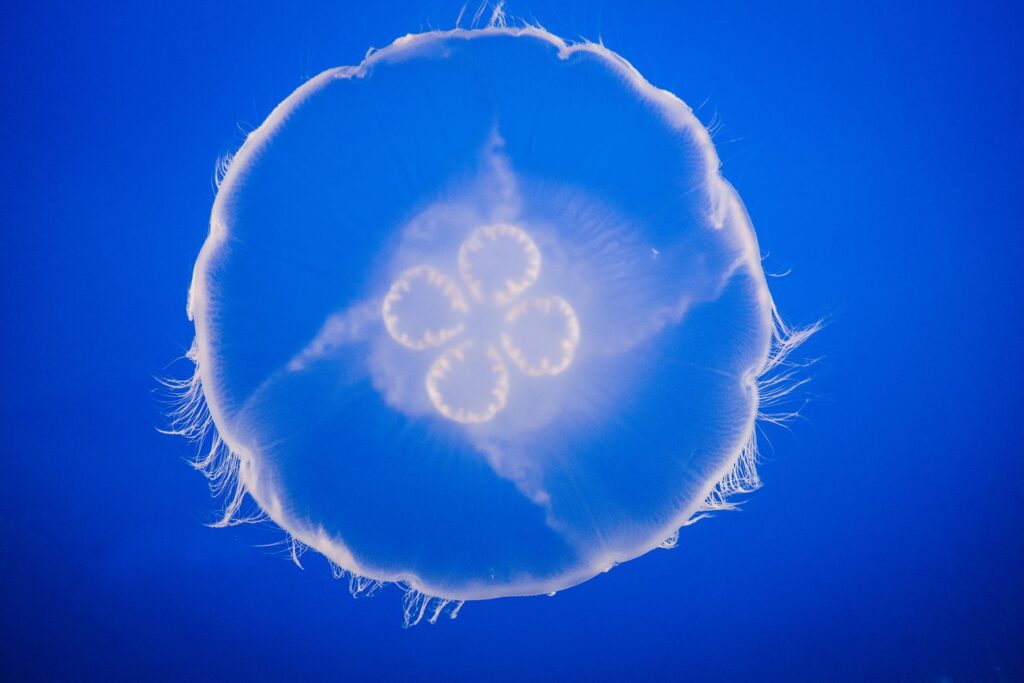
Moon jellyfish UK (Aurelia aurita), also called the Common jellyfish is the maximum not unusual jellyfish species on British shorelines. Moon UK jellyfish grow as much as 40cm in diameter. They have a obvious, umbrella-shaped bell edged with quick hair-like tentacles.
Moon Jellyfish are ninety five% water and have no mind, blood or coronary heart. They have most important tiers to their lifecycle: polyp and medusa. The latter is the adult, bell-formed, floating jellyfish we’re acquainted with.
Read in detail about: Herne Bay Pier
3- Blue UK Jellyfish
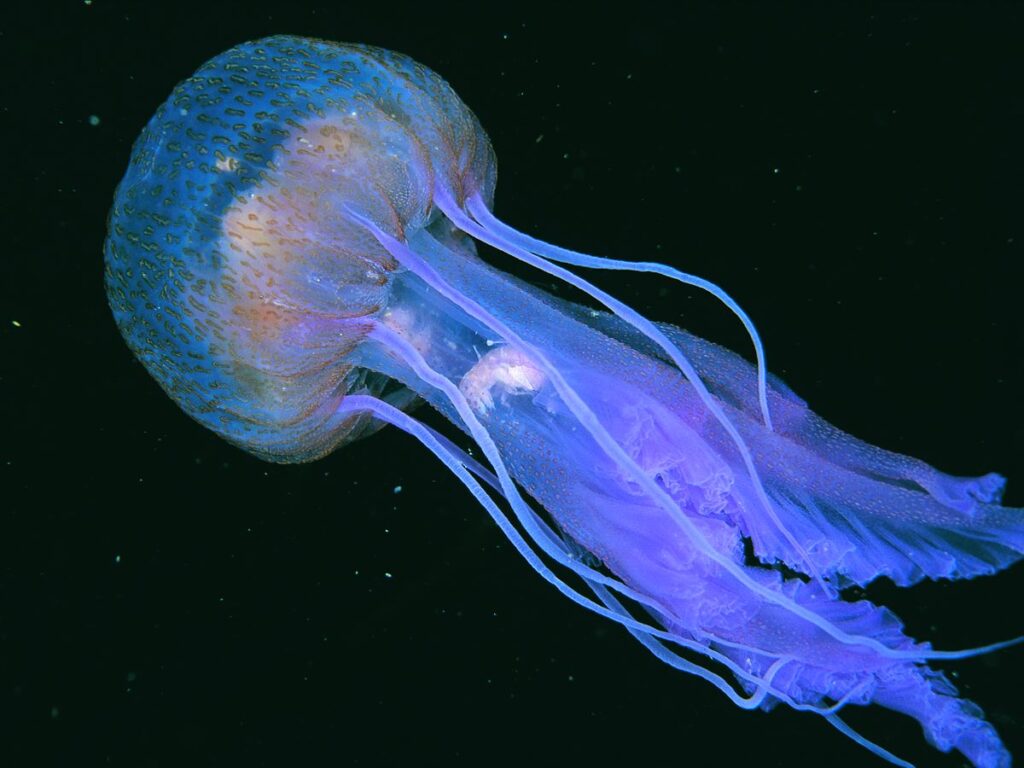
Blue UK jellyfish develop up to 30cm. A usual looking jellyfish, with a dome-shaped bell and stinging tentacles trailing underneath. The bell colour depends on adulthood and can range from pale yellow to pink. They’re a similar form to the lion’s mane jellyfish however are smaller and feature a blue bell through which radial strains can be visible.
A yellow colour variant also occurs in UK waters. It is not unusual within the South West and Wales at some stage in the past due spring to summer season months. However can also be seen along the North Sea shoreline.
4- Compass Jellyfish
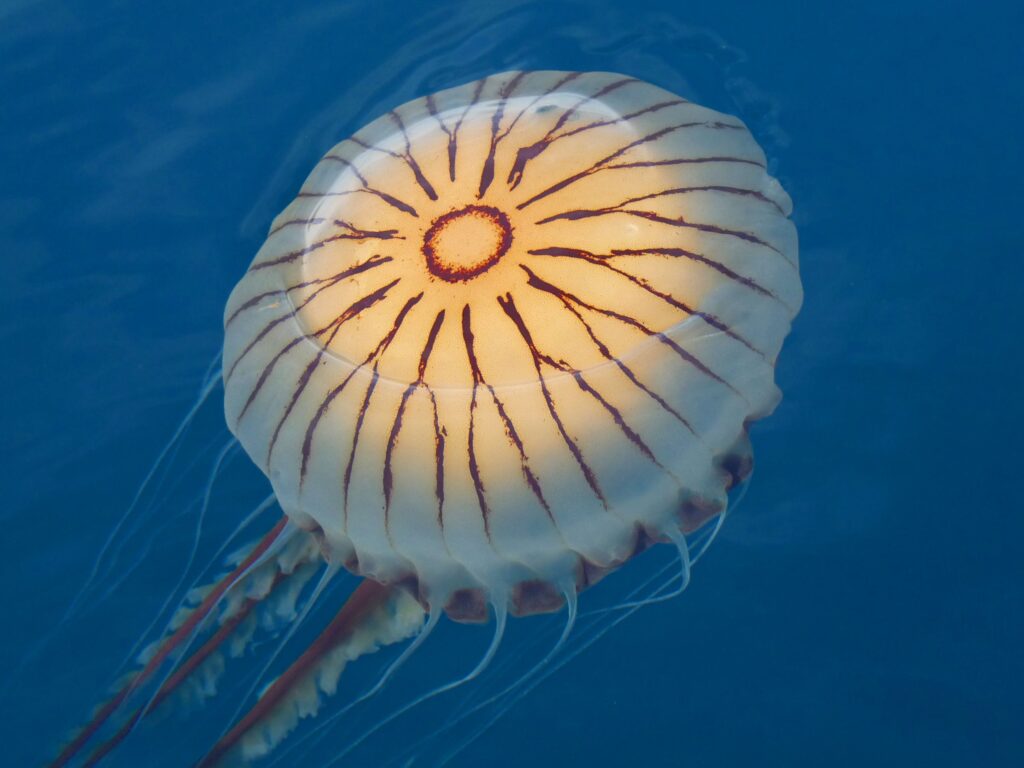
Compass jellyfish are characterized by V-formed brown stripes radiating out from the centre of the bell, similar to the factors of a compass. Compass UK jellyfish commonly develop up to 30cm.
The compass jellyfish are located particularly inside the southern half of the United Kingdom in the course of the summer time months. They have 24 long, thin tentacles and 4 lengthy, thick, frilled palms hang from the manubrium. Compass UK jellyfish sting can be pretty painful.
A detail guide on UK Burnham on SEA Pier
5- Lion’s Mane UK Jellyfish
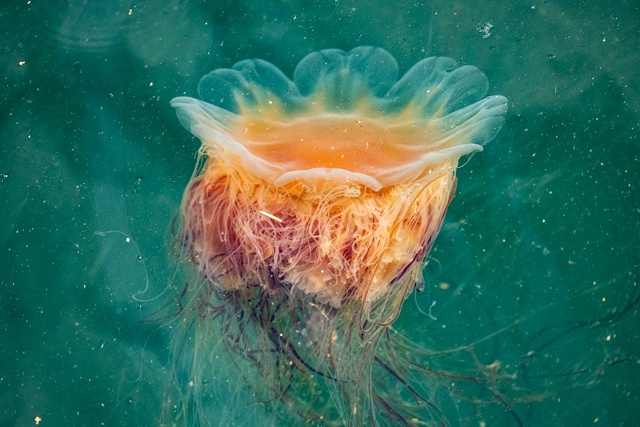
The lengthy flowing tentacles that surround the bell have all of the splendor and bite of a lionLion’s mane are massive – they’re normally 50cm, but can attain 2m in diameter. These tentacles are filled with stinging cells and are used to capture their favored prey.
The lion’s mane is a relative of the blue jellyfish. It prefers colder waters, so it’s miles observed especially from North Wales, right up to the north of Scotland and past. The Lion’s mane UK jellyfish is recorded as the second one longest animal in the global with tentacles that stretch for pretty away.
6- Crystal Jellyfish UK

Crystal jellyfish UK are beautiful. They are clear white transparent with fine lines emerging from the center. They are not often found in the UK except near on the shores of Cornwall. Crystal UK Jellyfish are believed for their glow when dark and devour jellyfish that are larger than them.
They also are stingy but not painful. The majority of them are transparent, except for an unidentified white structure that may not be jellyfish’s tentacles. There are four Aequorea species are found in UK waters.
7- Cross Jellyfish
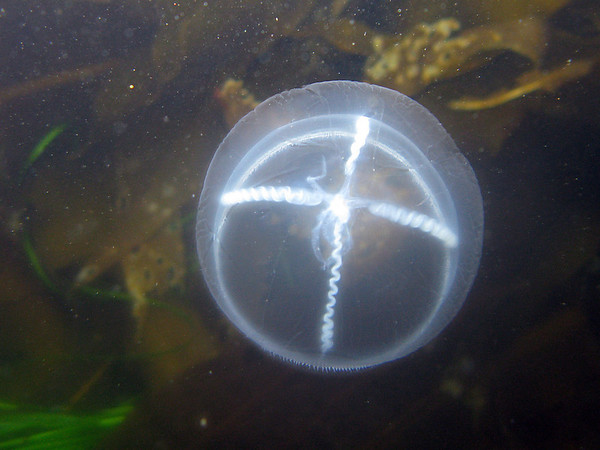
It is believed that the Cross Jellyfish may grow to 90 millimeters in size. They can have as many as 340 tentacles which are slim and flexible. They are not surrounded by apparent rings, or also clusters of Cnidocytes.
The Cross UK Jellyfish seems to be global in scope and is more prevalent farther north than the UK. However, it occasionally occurs in our waters in the northern part of the world in good numbers, often found in the same waters as Common UK Jellyfish. They have a smaller stomach, and out of it is an elongated manubrium that has four frilly lips.
Read detail article on Paignton beach Pier
8- Mauve stinger jellyfish
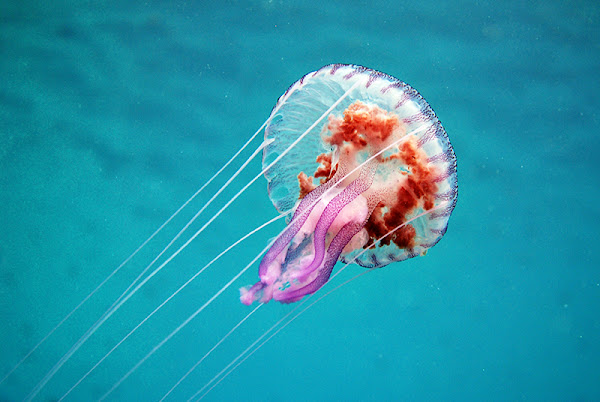
The mauve stinger can be described as a tiny jellyfish that is quite rare within the UK. It certainly packs a significant impact, with its long tentacles , and fragile structures on its bell that is stuffed with cells that sting. Tentacles that are long and thin hang from around the bell, and can reach the maximum of 3 meters.
The mauve stinger can be found in the Mediterranean in summer. Due to its unpleasant sting that can create problems in the tourism industry. It’s distinguish by its conical shape and is covered with mauve or pink warts. Four long , frilled arms rest on the bottom.
9- Portuguese Man O’War Jellyfish
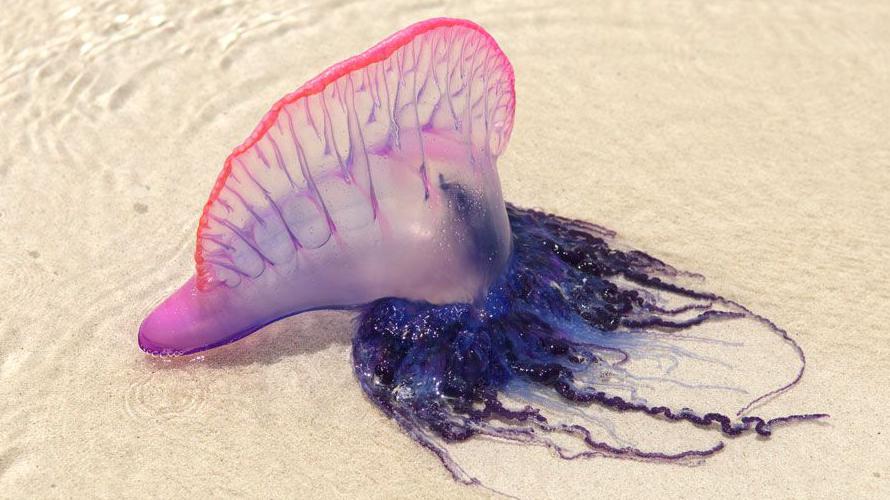
Portuguese Man’o’war can find themselves within UK waters and end in beaches. The stinging venom can paralyze tiny fish as well as other fish by the tentacles it wraps around the victim. It has been reported that this can occur to children as young as they get older which can have serious consequences.
A Potuguese Man O’War lives at the surface of the ocean, buoyed by the gas-filled bladder. The crest is a structure on top that functions as an sail. They aren’t able to swim and are dependent on the wind.
10- By-the-wind-sailor
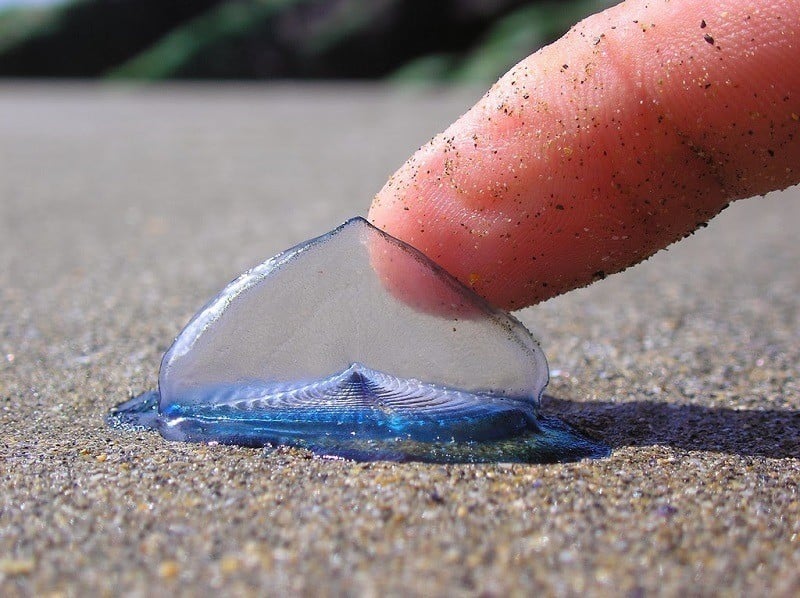
The blue-button sailor from By-the-Wind is an interesting Hydrozoans (Cnidarians) which live near the surface of water. Although they’re blue-colored and can be seen floating above the water , similar to the Portuguese Man of War (Physalia) but they aren’t terribly with it or other siphonophores.
By-the-wind-sailors can grow to be 10cm long and are blue purple in color. They sport an upright sail with a number of tiny tentacles that surround the mouth, which is located on the underside.
6 Facts About JellyFish
Jellyfish Have No Brain
As beautiful as those sea creatures are, they don’t really have a brain. Instead, the body is made from a complex frightened machine, which is wherein all in their motor functions and sensory pastime occurs.
Through the neurons in this system, the frame tells the muscle groups while to settlement, that is how they swim.
Which UK jellyfish Sting?
It is true that all UK jellyfish sting however, not all possess a sting sufficient to penetrate human skin. Therefore, we rarely notice it even. The majority of jellyfish that we see around the UK aren’t causing us any serious troubles, however there are some that could cause problems.
The moon jellyfish, is distinguished from its 4 pink rings is among the UK jellyfish that is generally believed to be safe. The Compass UK jellyfish has a long-toothed and can cause painful sting.
Jellyfish can contain millions of tiny tentacles with stinging cells also known as Nematocysts. These cells help take food items by injecting toxin on the victim. When we get stung, it is painful because the toxin is absorbed by our skin.
Jellyfish Are ninety eight% Water
The human frame is composed of 60% water and the jellyfish’s ninety eight%. When they wash ashore, they could disappear after only some hours, their our bodies promptly evaporating into the air.
They have a rudimentary apprehensive machine, a free community of nerves located within the dermis called a “nerve internet,” and no brain. Jellyfish additionally don’t have a coronary heart; their gelatinous our bodies are so thin they may be oxygenated solely by using diffusion.
They Eat Where They Poop
It may not sound very appetizing, however jellyfish don’t use separate orifices for eating and pooping. They have one orifice that does the task of both the mouth and the anus. The jellyfish is known as a easy or “primitive” animal, and its loss of a twin-hole gadget.
Still, the multifunctional gut opening is being constantly studied. In 2019, scientists located that one jellyfish species sprouts a new anus whenever it poops.
Jellyfish isn’t a fish
Though its call is jellyfish, it isn’t a fish. Fish is a vertebra, at the same time as jellyfish is an invertebrate. They don’t have a brain, spine-or principal apprehensive machine.
Jellyfish is a species that belongs to the phylum or elegance “Cnidaria,” animals which have stinging cells. In addition to this, “jellies” or “sea jellies” are brought to minimize the use of the phrase fish.
UK Jellyfish lifespan
A sea jelly’s existence span depends on various factors. First is their kind. Some jellyfish have a lifestyles span of 12 to 18 months; others live best for about 3 months to a year; some have a existence period of three to 6 months.
UK Jellyfish are seasonal creatures. Usually Jellyfish UK lifespan is up to 14 to 18 months.
Jellyfish UK Conclusion:
UK jellyfish play a massive position in masses of marine meals chains and provide habitats for smaller species which refuge below jellyfish bells, protected from predators with the aid of their tentacles.
Jellyfish are also a wonderful indicator of alternate in our ocean, so tracking their numbers each year can assist us to identify changes in weather, fishing interest or ecosystems.

